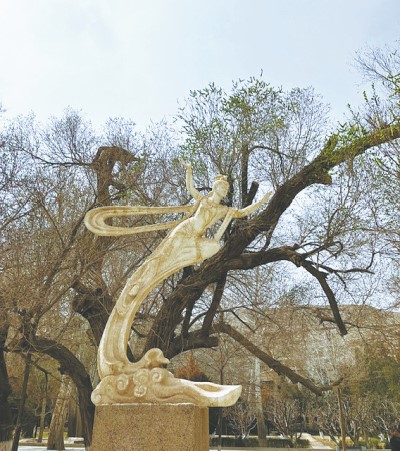Desert town in China retains old India link

The sculpture of a "flying apsara" or feitian,the modern-day cultural emblem of Dunhuang, Gansu province. [Photo by Satarupa Bhattacharjya/China Daily]
The statues of Buddha's prominent disciples, Kashyapa and Ananda, older and younger respectively, inside one cave have physical attributes that appear close to local people even while wearing dhoti, an Indian male garment. The Jataka tales on Buddha's reincarnations are mural motifs in some publicly open caves. "Flying apsaras", the celestial beings from Hindu and Buddhist mythologies, emerge elsewhere (Cave 296, for instance), and gradually become feitian (in Chinese), the modern-day cultural emblem of Dunhuang.
An exhibit at the nearby Dunhuang Museum of "eminent monks "who "came and went along the Silk Road" mentions Indian names, their travel years and work — the translation of sutras.
Chinese monk Xuanzang visited India over 17 years in the Tang era.
Other exhibits say the Han empire "started the early-stage exploration to Dunhuang by emigrating residents, establishing prefectures, counties and setting up a military defense system" at the westernmost end of the Hexi Corridor.
"The Confucianism culture in the Central Plains took root in Dunhuang, and the Indian Buddhist culture also spread to Dunhuang along the Silk Road," a museum document says.
Silk and paper were major export commodities from Dunhuang in the old trading days; major imports included woolen and linen fabrics, blood horses and rare birds (peacocks, for example), museum records show.
The grottoes house exquisite art and provide rich material to study politics (the rise and fall of dynasties and kingdoms), ethnic groups, society (a cave painting captures a prison scene) and folk customs. Dunhuang flourished under the Sui (581-618) and Tang dynasties, as well as the Five Dynasties and Ten Kingdoms (907-960), and saw the patronage of families that ruled the area from time to time. An artwork now used in Mogao merchandise portrays royal women of different ethnicities.





 Print
Print Mail
Mail
